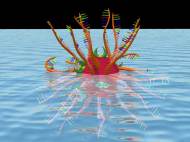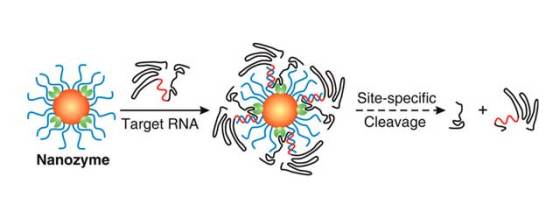Nanozyme nanoparticle selectively targets different diseases
 Aside their use in sci-fi, nanoparticles have emerged as a viable foundation for new ways to diagnose, monitor and treat disease. Current goal in development of nanoparticles used in medicine is to develop them in a way to selectively target only diseased cells, while leaving healthy cells unharmed. University of Florida (UF) researchers developed such a programmable particle which can prove useful in fight against cancer and other viral infections.
Aside their use in sci-fi, nanoparticles have emerged as a viable foundation for new ways to diagnose, monitor and treat disease. Current goal in development of nanoparticles used in medicine is to develop them in a way to selectively target only diseased cells, while leaving healthy cells unharmed. University of Florida (UF) researchers developed such a programmable particle which can prove useful in fight against cancer and other viral infections.
Led by Y. Charles Cao, a UF associate professor of chemistry, and Dr. Chen Liu, a professor of pathology and endowed chair in gastrointestinal and liver research in the UF College of Medicine, the researchers managed to treat hepatitis C virus on a cellular level by creating a tiny particle that can be programmed to shut down the genetic production line that cranks out disease-related proteins.
Current hepatitis C treatments involve the use of drugs that attack the replication machinery of the virus. However, the efficiency of those therapies averages around 50%, and they cause side effects such as flu-like symptoms, anemia and anxiety. The particle UF researchers developed can be tailored to match the genetic material of the desired target of attack, and it was developed in a way which increases therapy effectiveness and reduces side effects.
The new virus-destroyer, called a nanozyme, has a backbone of tiny gold particles and a surface with two main biological components. The first biological portion is an enzyme that can destroy the targeted mRNA gene. The other component is a large molecule called a DNA oligonucleotide that recognizes the genetic material and triggers the application of the enzyme.
In laboratory tests, the treatment led to nearly perfect results when it comes to decrease in hepatitis C virus levels. In addition, it did not trigger the body’s defense mechanism which leads to side effects. Despite the promising results, UF researchers stated their approach still needs additional testing to determine its safety.
Future therapies could potentially be in pill form. Aside being used in medical setting to fight disease, the technology could prove useful in detection and fight against viruses used as bioweapons.
For more information, you can read the article published in the Proceedings of the National Academy of Sciences: “Nanoparticle-based artificial RNA silencing machinery for antiviral therapy” [1.24MB PDF].










Leave your response!